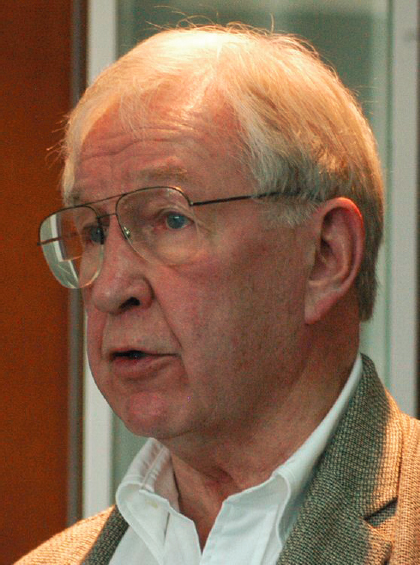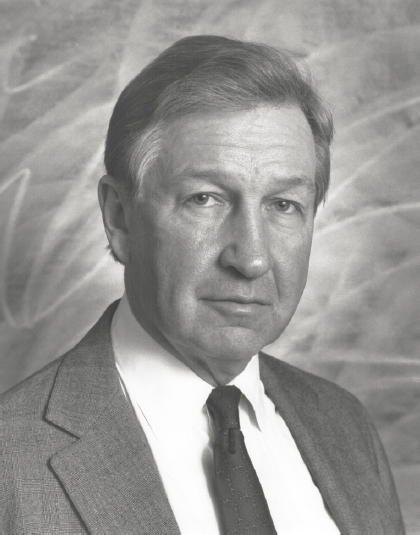

ROGER W. STAEHLE
1934–2017
Elected in 1978
“Contributions to the quality and strength of the national and international efforts to mitigate corrosion.”
BY RONALD M. LATANISION AND PETER L. ANDRESEN
ROGER WASHBURNE STAEHLE, founding director of the Fontana Corrosion Center at the Ohio State University and former dean of the Institute of Technology at the University of Minnesota, passed away January 16, 2017, after taking a fall while walking along the lake that he treasured and that his North Oaks home overlooked. He was a few weeks short of his 83rd birthday.
Roger was born February 4, 1934, to Carrie and Haswell Staehle in Detroit, and grew up in Columbus, Ohio, where he earned three degrees from the Ohio State University, all in metallurgical engineering: his BS and MS in 1957, and PhD in 1959. He was a doctoral student of the legendary Mars Fontana.
When he completed his first two degrees Roger became an officer and nuclear engineer (1957–61) with the US Navy and Atomic Energy Commission Naval Nuclear Reactor Development Program (with Vice Admiral H.G. Rickover). He then returned to Ohio State, as a research associate, and was promoted through the years to full professor by the time he left in 1979 to head the University of Minnesota’s Institute of Technology, where he was subsequently a professor of chemical engineering and materials science (1983–88). He was also president and chair of Automated Transportation Systems Inc. in Minneapolis (1984–86).
In addition to his teaching and research, much of it associated with the environmentally induced cracking of engineering materials and components, he was a master at failure analysis and forensic investigations. In 1988 he became an adjunct professor and served as a consultant to industry and government, a role in which his vast experience as a corrosion engineer was much in demand.
He edited 29 volumes on topics ranging from stress corrosion cracking (SCC) and hydrogen embrittlement to localized corrosion and intergranular crack growth in nuclear materials. Many of these volumes were conference proceedings, which were remarkable for Roger’s energy in attracting key contributors from around the world. Some were very broad in focus, others very specific; all were huge efforts and major contributions to the world’s progress. The volumes served to review the state of the art of the topic of interest and to set the research agenda for decades to come.
Roger was a mentor and encourager to thousands of researchers throughout the world and regularly organized conferences, workshops, and other forums for the exchange of data and ideas. For his expertise he was appointed to several committees of the National Research Council, including the Committee on the Waste Isolation Pilot Plant (1978–83), Panel on Review and Evaluation of Alternative Chemical Disposal Technologies (1995–96), and Panel on Survivability and Lethality Analysis (1998–99).
All engineering systems—from power plants to airframes to prosthetic devices—are constructed with materials and then put into service, often in environments that are hostile. Roger considered it important that engineers who design, build, operate, inspect, and maintain engineering systems understand the limits of chemical stability of all the materials of construction of such systems. No one contributed more to this understanding than Roger, including through his more than 220 papers.
Admirably, as research methods and the information they convey evolved, he was not reluctant to adjust to change. For example, in his paper Critical Analysis of Tight Cracks, published
in Corrosion Reviews, Roger pointed to a “paradigm shift” in considering mechanisms of stress corrosion cracking based on the use of sophisticated, modern analytical equipment. New experimental observations led him to consider tight cracks or molecular cracks that are just 1–5 nm wide, and he concluded that “There is evidence suggesting that the advance of SCC is a brittle process and is not associated with breaking of passive films. Studies of mature SCC after cracking at the crack tip show that the oxides formed do not come from the crack tip but rather from in-situ oxidation.” We shared the view that the unprecedented convergence of computational modeling and simulation software and experimental facilities that allow atom-order observation provides a new era of understanding of the many forms of environmentally induced cracking.
Roger was recognized for his remarkable work with an extensive list of honors. From the National Association of Corrosion Engineers (NACE) he received the Willis Rodney Whitney Award, presented for outstanding contributions to corrosion research (1980); T.J. Hull Award, presented for outstanding contributions in the field of publications (1992); and recognition as a NACE fellow for outstanding contributions and organizational skills in the field of corrosion research and dissemination of valuable scientific and engineering data (1993). His effectiveness in the classroom was recognized with an Award for Innovative Teaching (1975) from the Ohio American Society for Engineering Education. In addition to NACE and his NAE membership, he was a fellow of the Electrochemical Society and American Society of Metals, among others.
He was determined that the nuclear infrastructure industry in China become fully informed about the opportunities as well as the safety and reliability challenges of nuclear electric generation, and he was made an honorary professor of the Nuclear Power Institute of China and of the Suzhou Nuclear Power Research Institute.
Roger’s sense of humanity was legendary. Among his many gifts was the vision to see the essence of any issue, technical and nontechnical alike, and he always saw a path forward, a
solution. He often described this as political metallurgy. He could have been a very effective politician. He was the model for the adage that reasonable people can disagree without being disagreeable.
An outstanding photographer, his photographic tours of China and other parts of the world (all as part of technical interactions with his hosts) are thoughtful and moving. He became interested in other cultures, especially Buddhism, and in Asian art.
Roger Staehle worked on technical problems that interested and concerned him. His vast contributions made the world a better place. His influence was global, as was his presence; scientists and engineers all over this planet recognized him and his impact on corrosion science and engineering. NAE member and faculty colleague Robert A. Rapp wrote at the time of Roger’s passing in 2017 that “It is my opinion, perhaps widely shared, that Roger became the best metallurgist in the world in this specialty [nuclear materials], and as good as any metallurgist anywhere overall.”
Roger was the epitome of a technological statesman. We all have much to learn from his professional convictions and personal interaction with people all over the world.
He is survived by five of his children—Elizabeth Van Arsdale Krier, Eric Washburne Staehle, Sara Staehle Henry, Catherine Erin Staehle, and William Staehle—and six grandchildren. He was predeceased by his son George Washburne Staehle.
Roger’s children and grandchildren inherited many of his gifts and interests and are profoundly grateful for the gift of each other.






